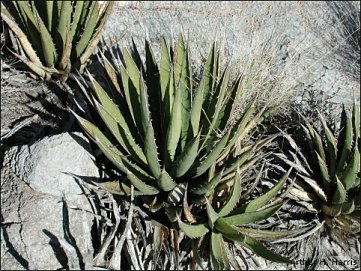

Various large agaves, also called century plants or magueys, have long been sources of important beverages. When the large head is cut from the center of the plant, a basin is formed. Sap pools in the basin and forms a nutritious drink called aguamiel, a valued source of water and nutrition in the desert.
Slightly fermented aguamiel furnishes a mild alcoholic drink called pulque, which was used in Aztec religious rituals. The early Aztecs invoked severe penalties for drunkenness. The Spanish fermented mashed, steamed agave heads. Distilling the liquid produced highly intoxicating mescal and tequila. Today huge farms near Guadalajara grow agave for the tequila distilleries.
The smallest and most abundant agave in Trans-Pecos Texas is
Lechuguilla. The leaves end in sharp, dangerous spines. Native Americans used the toxic
juice in the leaves as a poison for their arrows, a medicine, and a soap. The leaf
fibers were used for bow strings, nets, baskets, mats, sandals, blankets, and cloth.
The fibers are still used in Mexico and the United States for rope, twine, carpet pads,
rugs, and brushes.

Contributor: Elaine Hampton, College of Education, University of Texas at El Paso.
Desert Diary is a joint production of the Centennial Museum and KTEP National Public Radio at the University of Texas at El Paso.

Lechuguilla in the Franklin Mountains. Photograph by A.H. Harris.
Tull, D. 1987. Edible and useful plants of Texas and the Southwest. University of Texas Press, Austin.